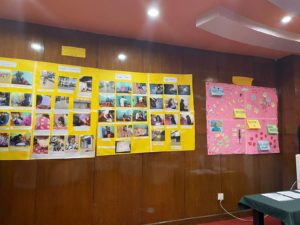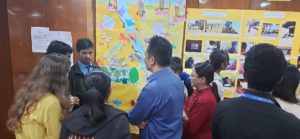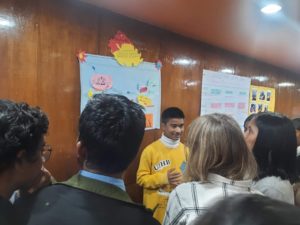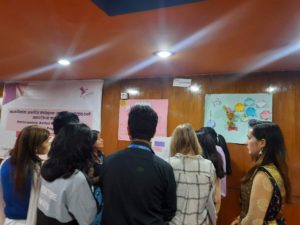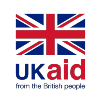Creativity, teambuilding and cooperative learning provide children with greater leverage in combating the worst forms of child labour (WFCL) that mostly exist in hidden spaces in small businesses in informal economies. An innovative approach to sharing ideas and work saw members—from different participatory research groups in Nepal with the CLARISSA Programme get together at a gallery walk held on 9th November 2022, in Kathmandu, Nepal.
There were 10 stalls on show, put together by members of the Action Research Groups (ARGs), the Children Research Group (CRG) and the Children Advocacy Group (CAG) who showcased their ideas using rich visuals such as colourful charts, drawings and artworks. Members of the visiting team from the Institute of Development Studies (IDS) rotated between the stalls and interacted with group members, including children and small business owners, asking about the progress of innovative actions each group were undertaking against WFCL in Nepal.
The CLARISSA Nepal team held this event for children and small business owners in the different research groups from Nepal’s entertainment sector to come together for the first time and share their journeys with support from the Participatory Action Research (PAR) facilitators and documenters. This process of sharing their lived experiences, including issues related to work conditions, abusive behaviour and maltreatment, helped them to better understand each other’s perspectives.
CAG members used the river of life technique to detail their advocacy activities and their experiences working in the group. Their illustrations of rivers, clouds, kites and hills meant different things such as their work, learnings, challenges and future plans. One ARG stall, from Manohara, drew an analogy between the solar system and their work in which they used planets, asteroids and moons to refer to their evidence and actions. Another ARG, from Sundhara, drew a tree to narrate their ideas. Other ARGs, from Balkumari, Koteshwor, Kalanki, Banglamukhi, Thamel and Gongabu, also used various artworks and drawings of rain, flowers, roads and gift cards. to depict their ideas.
Photos by CLARISSA Nepal team
It was interesting to see how these children worked cohesively as a team, adopted cooperative learning and high-level thinking to synthesize and creatively present ideas gleaned through the 400 life stories. After being part of these groups, the children in WFCL have developed the confidence to communicate their ideas in child-accessible formats, and champion their own cause to improve their life situations.
Business owners, who have their own ARGs, articulated their challenges including how they survived during the COVID-19 pandemic. The stall by the ARG comprised of female owners of khaja ghars (small snack shops) from the Gongabu area. They showed, through their artwork, that they had found the confidence to challenge the general misconception that their businesses are shady places where sexual acts take place. They reflected on the deepened trust among themselves and an understanding of the importance of taking action at the association or federation level, which is more effective than at an individual level. The participants were also able to talk about their groups’ roles within the sphere of CLARISSA Nepal’s participatory action research initiative.
“Today I became aware of linkages between the child-led ARGs and CAG. I realize that an ARG works to generate evidence against the worst forms of child labour, whereas CAG advocates with stakeholders outside (against WFCL) based on evidence generated by the ARG” shared a female participant from the Sundhara ARG.
In his closing remarks, Danny Burns, the Director of CLARISSA Programme at IDS, said there was so much adults could learn from children’s creativity. Explaining that children and business owners together have a huge potential to change things for the better, he said: “You have more power than you think. Children have a lot of pathways to communicate. Business owners are influential to change their own community. So, it’s coming together which allows you to release that power (for creating change).”
Video by CLARISSA Nepal team
Citing an example involving one female CAG member— who had earlier shared at the event that while analysing the life stories, she understood the consequences of marrying early, and stopped her child marriage by talking to and convincing her parents— Burns said “You have already created changes, sometimes small changes. You say that it (the adult entertainment sector) is a stigmatised sector. You are already changing peoples’ perception of who you are by the evidence you are communicating.”
He concluded by saying to the children: “Never lose that power to be creative. Never lose your playfulness. Always have colours in the room. However bad things are, those will make you feel better and it will help you create change.”
